Belly fat, often regarded as an aesthetic concern, goes far beyond skin-deep implications. Reducing excessive abdominal fat is crucial, not just for a toned appearance, but more importantly for one’s overall health. Accumulation of belly fat, especially the deeper visceral kind, has been linked to a host of medical issues including heart disease, type 2 diabetes, and certain cancers.
As we dive into effective exercises to tone and strengthen the abdominal region, it’s essential to debunk a common fitness myth: spot-reducing or the belief that one can target fat loss in a specific area of the body by only exercising that part. The reality is, the body decides where it sheds fat, and it’s often a holistic process influenced by genetics, diet, and overall activity. However, certain exercises burn calories more efficiently and engage core muscles intensively, contributing to a more toned midsection. In this article, we’ll explore seven of these powerhouse exercises to help you move closer to your fitness goals.
The Science Behind Burning Belly Fat
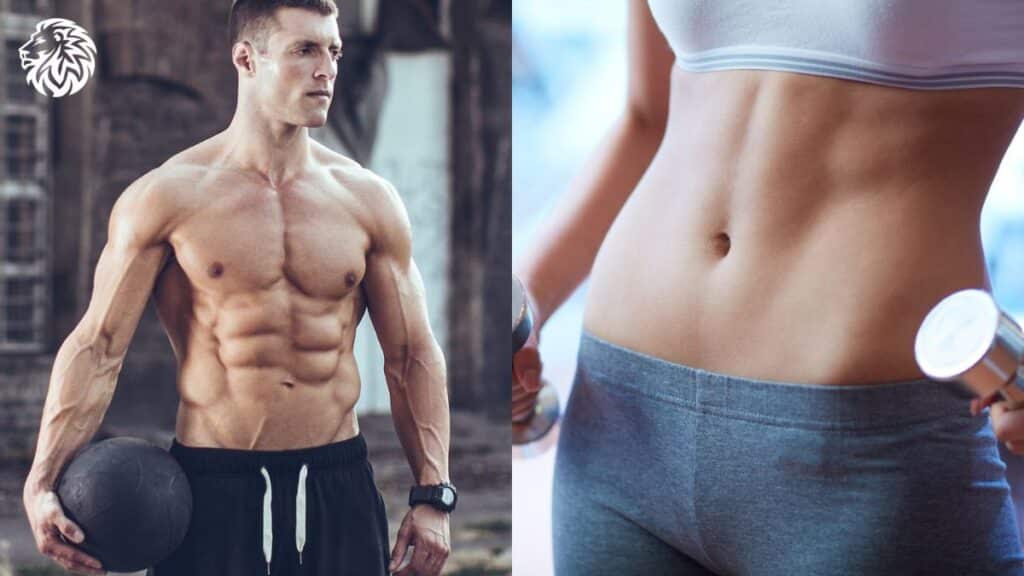
The journey to understanding belly fat begins at the cellular level. Fat, scientifically termed as adipose tissue, consists of cells called adipocytes that store excess energy from the food we consume. When our body needs energy and isn’t receiving it from immediate food sources, it starts breaking down these fat stores into usable energy in a process called lipolysis. This leads to the burning of fat.
However, not all belly fat is created equal. There are two primary types:
- Subcutaneous Fat: This is the fat you can pinch. Located right beneath the skin, subcutaneous fat contributes to body insulation and serves as an energy reserve. It’s spread throughout your body and is the type most people are eager to shed for cosmetic reasons.
- Visceral Fat: Nestled deeper within the abdominal cavity, surrounding vital organs like the liver and intestines, visceral fat is of greater concern. It’s metabolically active and can secrete inflammatory substances, raising the risk for chronic diseases like heart disease, diabetes, and more.
Given the differing nature and risks associated with these fats, it’s essential to approach fat loss comprehensively. Aerobic exercises, commonly known as cardio, like running or swimming, are efficient at burning calories and hence fat. However, they might not be enough on their own. Strength training exercises, which build muscle mass, are equally crucial. Muscle tissue is metabolically more active than fat tissue, meaning it burns more calories even at rest. By combining cardio with strength training, not only do you optimize fat loss, but you also ensure a balanced, toned physique and a boost in metabolic rate.
Exercise 1: High-Intensity Interval Training (HIIT)
High-Intensity Interval Training, popularly known as HIIT, is a cardio workout strategy that alternates short bursts of intense activity with periods of rest or lower-intensity exercise. By doing so, it pushes the body to its limits in a short time, providing an efficient workout that’s both time-saving and effective.
Benefits of HIIT:
- Efficient Calorie Burn: Due to its intensity, HIIT can burn a lot of calories in a short period.
- Boosts Metabolism: HIIT can elevate the metabolic rate for hours post-workout, leading to an increased calorie burn, often referred to as the afterburn or the “EPOC” (Excess Post-exercise Oxygen Consumption).
- Heart Health: Regular HIIT can improve cardiovascular health, increasing heart strength and endurance.
- Convenience: Given its efficiency, HIIT workouts are generally shorter, making them ideal for those with busy schedules.
- No Equipment Necessary: While equipment can be incorporated, many HIIT workouts rely solely on body weight, making them easily accessible.
Sample HIIT Routine Targeting the Core:
Warm-up (5 minutes):
- Jumping jacks: 1 minute
- Arm circles (both directions): 1 minute
- Leg swings (front and back): 1 minute
- Side-to-side lunges: 1 minute
- Spot jogging: 1 minute
Core-focused HIIT Circuit (repeat 3-4 times with a 1-minute rest between circuits):
- Burpees: 30 seconds on, 30 seconds off
- Mountain Climbers: 30 seconds on, 30 seconds off
- Plank Jacks: 30 seconds on, 30 seconds off
- Russian Twists: 30 seconds on, 30 seconds off (can use a weight for added resistance)
- High Knees: 30 seconds on, 30 seconds off
Cool Down (5 minutes):
- Forward bend stretch: 1 minute
- Child’s pose: 1 minute
- Seated torso twist (each side): 1 minute
- Butterfly stretch: 1 minute
- Deep breathing and relaxation: 1 minute
Remember, always consult with a fitness professional or healthcare provider before starting a new workout regimen, especially high-intensity ones like HIIT.
Exercise 2: Planking
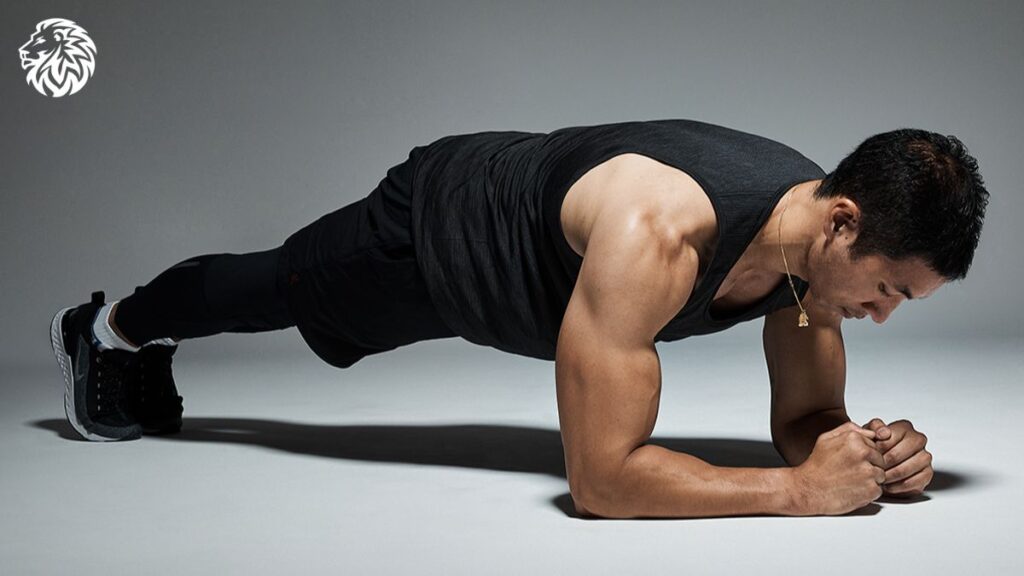
The plank is a powerhouse exercise that engages a variety of muscles, primarily targeting the core. It’s an isometric hold that strengthens and tones not just the abdominal muscles but also the back, shoulders, and glutes.
How to Properly Perform a Plank:
- Position: Start in a push-up position, but instead of placing your weight on your hands, use your forearms. Ensure your elbows are directly under your shoulders.
- Alignment: Keep your body in a straight line from the top of your head down to your heels. This means your hips shouldn’t sag or be lifted too high.
- Engage Core: Tighten (or brace) your core as if you’re about to be punched in the stomach. This engagement protects your lower back and maximizes the exercise’s effectiveness.
- Hold: Keep your neck neutral, looking down or slightly ahead. Breathe deeply and hold this position for as long as you can maintain good form.
Variations to Increase Intensity:
- Side Plank:
- Start by lying on one side, with legs straight.
- Prop yourself up with your elbow directly beneath your shoulder.
- Lift your hips so your body forms a straight line from head to heels.
- Hold the position, engaging your core. Then switch to the other side.
- Plank Jacks:
- Begin in the standard plank position.
- Jump your feet out to the sides (like doing a horizontal jumping jack) and then back in.
- Keep your core engaged and try to maintain a straight line with your body throughout.
- Plank with Leg Lift:
- Start in the basic plank position.
- Slowly lift one leg a few inches off the ground, keeping it straight.
- Hold for a few seconds, then switch legs.
- Plank to Push-Up:
- Start in the forearm plank position.
- Push up from one arm to extend it fully, followed by the other arm until you’re in a push-up position.
- Return to the starting position by lowering one forearm to the ground and then the other.
- Plank with Arm Reach:
- From the plank position, extend one arm straight out in front of you.
- Hold for a few seconds, then return to the starting position and switch arms.
By incorporating these variations into your routine, you can challenge different muscle groups and prevent plateaus in your progress. Remember, form is crucial, so always prioritize maintaining proper alignment over holding the plank for an extended period or adding variations.
Exercise 3: Burpees
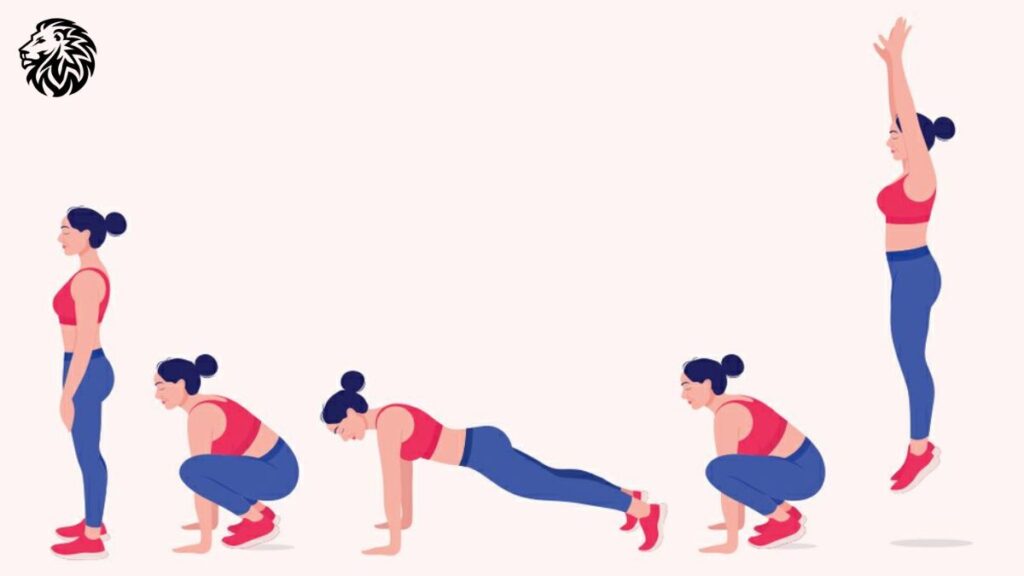
Often dubbed as one of the most dreaded yet effective full-body exercises, burpees offer a potent blend of strength training and aerobic elements. They’re a compound exercise that can significantly boost endurance, strength, and agility.
Step-by-Step Guide to Doing Burpees:
- Starting Position: Stand with your feet shoulder-width apart and your arms at your sides.
- Squat Down: Bend at the hips and knees to go into a squat position. Place your hands flat on the floor in front of you.
- Kick Back: In a swift motion, jump your feet backward, landing in a plank position. Your body should be in a straight line from your head to your heels.
- Push-Up (Optional): For an added challenge, you can do a push-up here. Bend your elbows and lower your chest to the floor, then push back up to the plank position.
- Jump Forward: Jump your feet back towards your hands, returning to the squat position.
- Explosive Jump: From the squat position, explosively jump into the air, reaching your arms overhead.
- Land Softly: Land gently back into the starting position, bending your knees slightly to cushion the landing, and immediately go into your next repetition.
Explanation of How Burpees Engage Multiple Muscle Groups:
Burpees are a compound exercise, meaning they engage multiple joints and muscle groups simultaneously.
- Legs: The squatting and jumping elements work the quadriceps, hamstrings, glutes, and calves.
- Core: Maintaining the plank position and jumping the feet back and forth challenges the abdominal muscles, obliques, and lower back.
- Chest and Arms: If you incorporate the push-up, you engage the chest, triceps, and shoulders.
- Cardiovascular System: The explosive and rapid nature of burpees gets the heart rate up, providing an excellent cardiovascular workout and promoting fat burn.
Given the intense nature of burpees, they’re not only great for muscle strengthening and cardiovascular endurance but also highly effective for calorie burning. However, because they’re high impact, always ensure you’re performing them with proper form to avoid injury and consider modifications if needed.
Exercise 4: Mountain Climbers
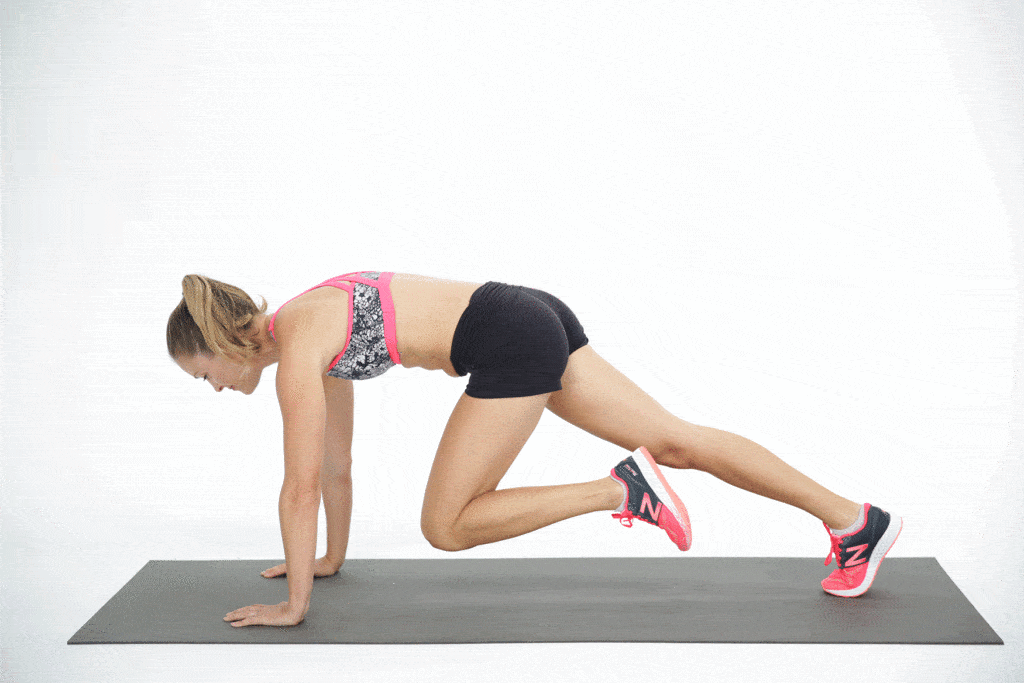
Mountain climbers are a dynamic exercise that combines the plank’s core-stabilizing benefits with a cardiovascular challenge, making them a fantastic addition to any workout routine.
Instructions for Mountain Climbers:
- Starting Position: Begin in a plank position, with your hands placed directly under your shoulders and your body forming a straight line from your head to your heels.
- Engage Core: Tighten your core, ensuring your hips don’t sag or lift too high.
- Climbing Motion: Bring your right knee towards your chest as far as you comfortably can. Ensure your foot is off the ground.
- Switch Legs: Swiftly switch your position by extending your right leg back to the starting position while simultaneously driving your left knee towards your chest.
- Maintain Rhythm: Continue to “climb” by alternating knees in a fast-paced motion. Your body will look like it’s “running” in the plank position.
- Breathing: Remember to breathe steadily throughout the exercise. Avoid holding your breath.
- Duration: Aim for sets of a specific duration, such as 30 seconds to a minute, or a certain number of reps.
Benefits for the Core and Cardiovascular System:
- Core Strength: Mountain climbers require stabilization of the core as you bring each knee forward. This action engages the rectus abdominis, obliques, and the transverse abdominis, leading to improved core strength and stability.
- Cardiovascular Endurance: Due to the dynamic nature of the movement, mountain climbers raise your heart rate quickly. When performed at a faster pace, they can be an excellent cardiovascular workout, enhancing heart health and stamina.
- Calorie Burn: The combination of core engagement and cardiovascular intensity can lead to an effective calorie burn, aiding in weight loss and overall fitness.
- Full Body Engagement: Beyond the core and heart, mountain climbers also work the deltoids, biceps, triceps, quads, and even the hip flexors, making them a comprehensive full-body exercise.
Incorporating mountain climbers into your routine can offer both strength and cardiovascular benefits. As with all exercises, it’s essential to maintain proper form to maximize benefits and reduce the risk of injury.
Exercise 5: Russian Twists
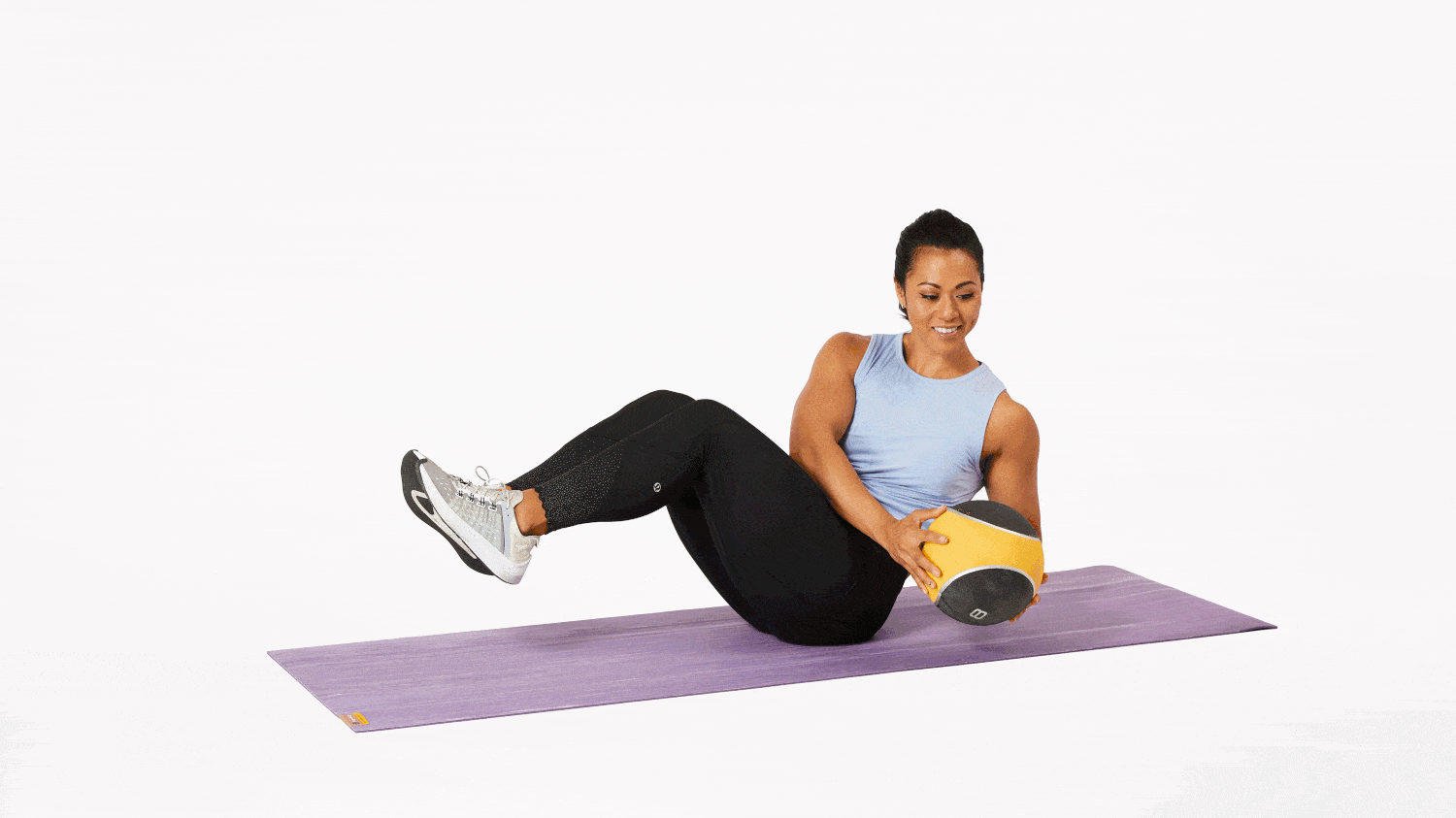
Russian twists are a fantastic core exercise that targets the oblique muscles, helping to sculpt and define the sides of the abdomen. When performed with precision and proper form, they can be a beneficial addition to any core-focused routine.
How to Perform Russian Twists with Proper Form:
- Starting Position: Sit down on the floor with your legs extended in front of you. Lean back slightly, keeping your spine straight, until your torso is at about a 45-degree angle to the floor.
- Engage Core: Tighten your abdominal muscles. This not only ensures efficacy but also helps protect the spine.
- Bend Knees: Lift your feet off the ground by bending your knees, bringing them towards your chest. Your legs should be hovering with your shins parallel to the ground.
- Hand Position: Clasp your hands together in front of you or hold them out straight.
- Twisting Motion: Rotate your torso to the right, trying to bring your hands towards the ground beside your hip. Return to the center and then rotate to the left. That completes one rep.
- Breathing: Exhale as you twist and inhale as you return to the center.
- Gaze: Keep your eyes following your hands to ensure you’re getting a good twist in the torso.
Tips for Increasing Intensity:
- Add Weights: Holding a weight, like a dumbbell or a medicine ball, can significantly increase the intensity of the Russian twist. When using a weight, ensure you’re still able to maintain proper form. Holding the weight, twist your torso, and try to touch the weight to the floor beside your hip on each side.
- Extend Legs: Straightening your legs and lifting them higher will engage your lower abdominals more and make balancing more challenging.
- Increase Reps or Duration: Rather than doing a set number of reps, you can aim to do Russian twists for a set amount of time, like 30 seconds to a minute. As you advance, increase this duration.
- Faster Pace: Without compromising on form, picking up the pace can add a cardio element to the exercise, increasing the calorie burn.
Always remember that quality is more important than quantity. It’s better to do fewer repetitions with correct form than many repetitions with poor form, which can lead to strain or injury. If you’re new to Russian twists or are adding weights, it may be beneficial to consult with a fitness professional to ensure you’re executing the movement safely.
Exercise 6: Bicycle Crunches
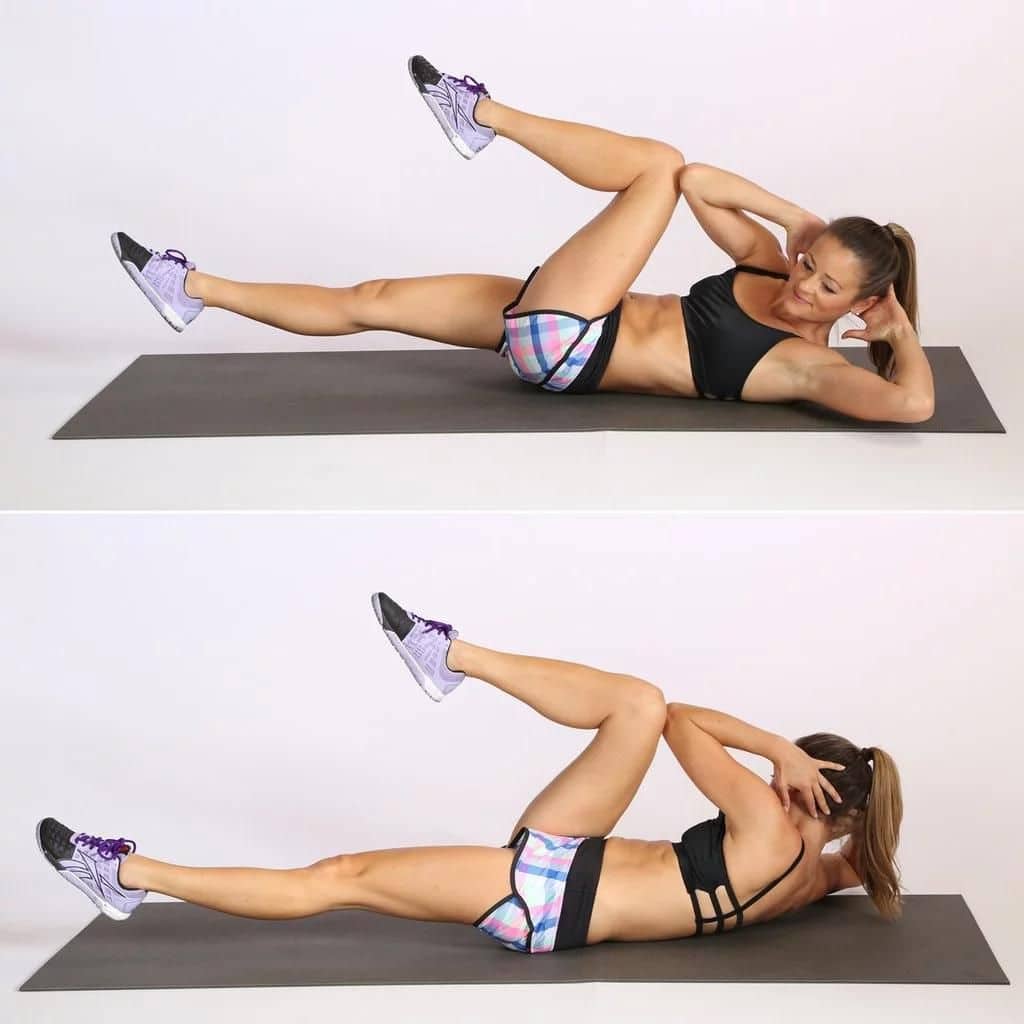
Bicycle crunches are a dynamic abdominal exercise that targets multiple areas of the core, making them a popular choice for those looking to achieve a well-rounded core workout.
Proper Form and Technique for Bicycle Crunches:
- Starting Position: Lie flat on your back on a mat, ensuring your lower back is pressed to the ground. Place your hands lightly behind your head, elbows flared out to the sides.
- Engage Core: Tighten your abdominal muscles, which will help protect your spine and make the exercise more effective.
- Lift Legs: Raise your legs, bending your knees to about a 90-degree angle.
- Initiate Movement: Lift your head, neck, and shoulders slightly off the ground. Rotate your torso to bring your right elbow towards your left knee while simultaneously extending your right leg straight out and hovering it above the ground.
- Alternate: Switch sides by bringing your left elbow towards your right knee while extending your left leg. This continuous pedaling motion resembles riding a bicycle.
- Breathing: Exhale as you twist and bring your elbow to the opposite knee, and inhale as you switch sides.
- Avoid Straining: Ensure you’re not pulling on your neck. Your hands are merely there to support the head. The movement should come from the core, not the neck.
Explanation of Muscles Worked:
- Rectus Abdominis: This is the primary muscle in the abdomen, often referred to as the “six-pack” muscle. It’s engaged when you lift your head, neck, and shoulders off the ground.
- Obliques: Both the internal and external obliques are activated when you perform the twisting motion. They’re located on the sides of the abdomen and are responsible for rotating and side-bending the trunk.
- Transverse Abdominis: This deep abdominal muscle acts as a stabilizer throughout the exercise, keeping your spine protected and aiding in the rotation of the torso.
- Hip Flexors: Located at the top of the thighs, these muscles are engaged when you’re drawing your knee into your chest.
Bicycle crunches, when executed with proper form, offer a comprehensive workout for the entire core region. As with all exercises, it’s essential to prioritize form over speed or repetitions to maximize benefits and minimize the risk of injury.
Exercise 7: Jumping Rope
Jumping rope isn’t just a playground pastime; it’s a highly effective cardio exercise that offers numerous health and fitness benefits. When done with intensity and proper technique, it can be a fantastic tool for burning calories and toning the core.
Benefits of Jumping Rope for Burning Calories and Toning the Core:
- Calorie Burn: Jumping rope can burn upwards of 10-20 calories a minute, depending on the intensity, making it one of the top exercises for calorie burn.
- Cardiovascular Health: The aerobic nature of the exercise strengthens the heart, improves lung capacity, and enhances overall cardiovascular health.
- Core Engagement: While it might not seem like it at first, jumping rope requires significant core stabilization. Your abdominal muscles are continuously engaged to maintain balance and posture, effectively toning and strengthening the midsection.
- Full Body Workout: Beyond the core, jumping rope also engages the legs, particularly the calves, and the arms, especially the forearms and shoulders.
- Coordination & Agility: Regularly jumping rope can improve hand-eye coordination and boost agility, skills that can benefit you in various sports and daily activities.
Tips for Incorporating Jumping Rope into a Workout Routine:
- Start Slow: If you’re new to jumping rope, begin with short intervals, like 20-30 seconds of jumping followed by a rest, and gradually increase the duration as your stamina improves.
- Variety: Add variations like double unders (the rope passes under your feet twice in one jump), high knees, or alternating foot jumps to keep things challenging and engaging.
- Combine with Strength Training: Use jumping rope as a cardio interval between strength training sets. This type of combination can create a high-intensity interval training (HIIT) effect, boosting calorie burn.
- Track Progress: Use a timer or a jump rope with a built-in counter to track how many jumps you can do in a set amount of time. Aim to improve your numbers as you progress.
- Proper Footwear: Wear good quality, supportive shoes to reduce the impact on your joints. Cross-training shoes or those designed for high-impact workouts are generally suitable.
- Jump on Soft Surfaces: If possible, try to jump on softer surfaces like wooden floors, gym mats, or grass, which can reduce the impact on your joints compared to concrete or asphalt.
- Regular Maintenance: Ensure your jump rope is the right length for your height and check it regularly for wear and tear. Replace it as needed.
Incorporating jumping rope into your workout routine can provide a fun and efficient way to boost cardiovascular health, burn calories, and tone the core. Remember to maintain proper form and listen to your body to prevent injuries.
Diet and Nutrition: Complementing Your Exercise Routine
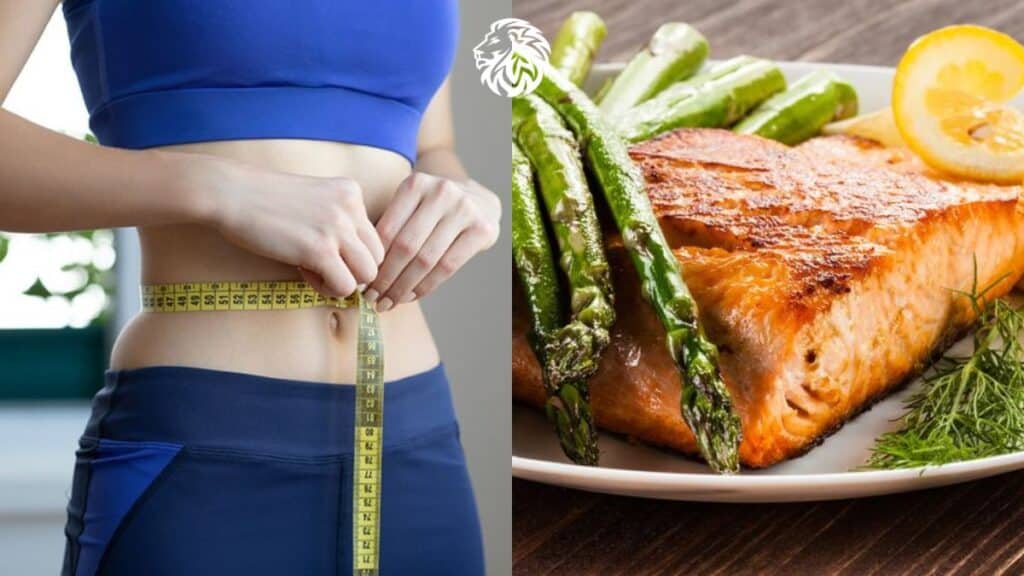
Exercise alone won’t yield the results you’re hoping for, especially when targeting belly fat. Diet and nutrition play an equally crucial role in your fitness journey. By complementing your exercise routine with a balanced diet, you can achieve optimal results and overall well-being.
Overview of the Role of Diet in Burning Belly Fat:
- Caloric Balance: At its core, weight loss is about burning more calories than you consume. No matter how much you exercise, if you’re consuming more calories than you’re burning, it’ll be challenging to lose weight and shed belly fat.
- Macronutrient Composition: The balance of carbohydrates, proteins, and fats in your diet can influence fat loss. Diets higher in protein can support muscle growth and maintenance, which in turn can boost metabolism.
- Processed Foods: Highly processed foods often contain unhealthy fats, sugars, and sodium, which can lead to weight gain, especially around the abdominal area. Minimizing these foods can aid in reducing belly fat.
Foods That Help Boost Metabolism:
- Protein-Rich Foods: Lean meats (chicken, turkey), fish, tofu, legumes, and dairy products can increase the thermic effect of food, causing your body to burn more calories while digesting.
- Green Tea: Contains catechins, which can help boost metabolism and promote fat burning, especially in the abdominal area.
- Capsaicin: Found in chili peppers, capsaicin can increase metabolic rate and promote fat burning.
- Whole Grains: Foods like quinoa, brown rice, and whole wheat bread require more energy to break down, helping to boost metabolism.
- Water: Drinking water can temporarily boost metabolism. Cold water might be especially effective as the body uses energy to heat it to body temperature.
Importance of Staying Hydrated:
- Metabolic Boost: Even mild dehydration can slow down the metabolic rate. Staying hydrated ensures that your metabolism functions at its best.
- Appetite Control: Sometimes, the body confuses thirst with hunger. Drinking water can help you feel full and might reduce overall calorie consumption.
- Digestion and Detoxification: Water aids in digestion, preventing constipation, and helps the liver metabolize stored fat more efficiently.
- Enhanced Physical Performance: Proper hydration ensures optimal physical performance, allowing you to get the most out of your workouts.
- Temperature Regulation: Water helps regulate body temperature, ensuring that your body operates efficiently during workouts and throughout the day.
While exercises targeting the core can help tone abdominal muscles, reducing belly fat requires a holistic approach that integrates both physical activity and proper nutrition. Adopting a balanced diet, staying hydrated, and incorporating metabolism-boosting foods can significantly aid in achieving your fitness goals.
Conclusion
Achieving a toned midsection and reducing belly fat isn’t just about the exercises you perform but also about the lifestyle choices you make. From High-Intensity Interval Training (HIIT) that revs up your heart rate and calorie burn, to core-specific moves like planking and Russian twists that sculpt and strengthen, each exercise we discussed brings its unique set of benefits to the table.
But it’s essential to remember that exercise alone isn’t a silver bullet. As we delved into the importance of diet and nutrition, it’s clear that what you consume plays an equally vital role in achieving your fitness goals. Foods that boost metabolism and proper hydration not only complement your workouts but are fundamental in promoting overall health.
Incorporate the exercises listed into your routine, fuel your body with nutrient-rich foods, and maintain consistency in your efforts. Over time, with dedication and perseverance, the results will undoubtedly follow.
Embrace the journey, and remember that your efforts in the gym are only as effective as your choices in the kitchen. Combining a robust exercise regimen with a balanced diet is the winning formula to achieving a healthier, more toned you. So, gear up, stay committed, and let every choice propel you closer to your goals.







